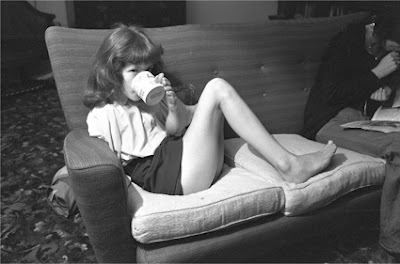My last post highlighted the increasing ability to manipulate and construct our physical bodies...to become our own architects. As I mentioned, the French perfromance artist, Orlan explores these ideas in an extreme manor by using her own body to question body conventions. During the 1990's Orlan underwent a series of cosmetic surgeries to transform her face. In her postmodern approach to aesthetic, Orlan chose to rebuild her face by replicating the body parts of five women; chosen for the mythology surrounding them. The hybrid result was made using the chin of Botticelli's Venus Goddess, the forehead of Leonardo's Mona Lisa, the mouth of Boucher's Rape of Europe, the eyes of jean-leon gerome's psyche and the nose of a statue of Diana. Orlan explained that 'I tried to use surgery not to better myself or become a younger version of myself, but to work on the concept of image and surgery the other way round. She described her work as 'Carnal Art' which was 'not against cosmetic surgery, but rather against the conventions carried out by it' and 'the dominant ideology that impresses itself more and more on feminine...flesh. ' Orlan's work demonstrates a drastic representation of how we are able to completely reconstruct ourselves.
 |
| 'Reincarnation of Orlan' |
Manipulating the face through the use of temporary, external structures has also been analysed by a variety of contemporary artists and designers. It draws on ideas surrounding the boundary between the body and objects and their ability to distort that boundary.
 |
| Left to Right: Lucy McRae, Burcu Buyukunal, Imme van der Haak |
Lucy Mcrae has become increasingly well known in contemporary practice, referring to herself as a body architect. Having trained as a ballet dancer and studied architecture and fashion, McRae developed a profound interest in the human body. Her work presents an investigation into the way technology can merge with biology in our own bodies. In reference to her more spontaneous creations McRae explained that she became 'obsessed with this idea of blurring the perimeter of the body, so you couldn't see where the skin ended and the near environment started'; effectively altering the silhouette of the body. It's common for fashion to play with the human silhouette but I think it is interestingly seen less in everyday jewellery...does jewellery need to be large in scale to manipulate the human silhouette? The images below exemplify ways in which the body's boundary can be manipulated.
 |
| L to R: Maurice Seymour, Gregoire Alexandre. My last post also featured the work of Rebecca Horn, whose oeuvre heavily centres around the human body. Horn's surreal constructions question the boundary between our physical bodies and our inner selves, as well as the 'reciprocal relationship between self and context.' Her finger gloves created an extension that simultaneously enhanced her ability to touch whilst distancing the rest of her body from the surrounding space. The piece below demonstrates the the more intimate connection between body and self. The woven tube extends from the mouth which then divides to cover both breasts, creating a triangular shape, as 'one's perception expands triangularly'. Many of Horn's pieces incorporate feathers or wings which she consciously uses to create a 'tactile extension of the outer skin'. Horn's constructed objects don't simply sit on the body, they use it to question the perceptions and limitations of it. Rebecca Horn, 'Cornucopia, Seance for Two Breasts' 1970 |
 |
| Salvador Dali by Richard Avedon |













































